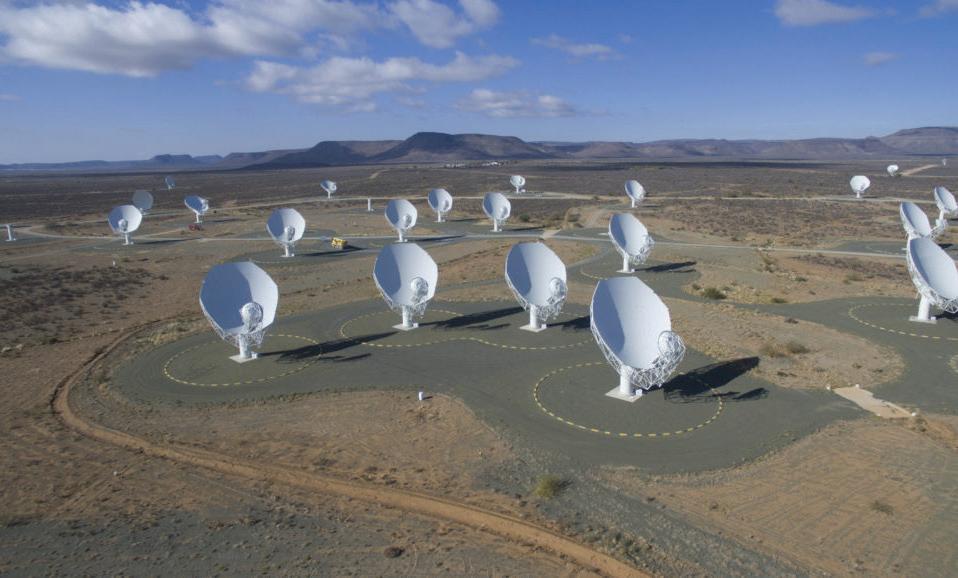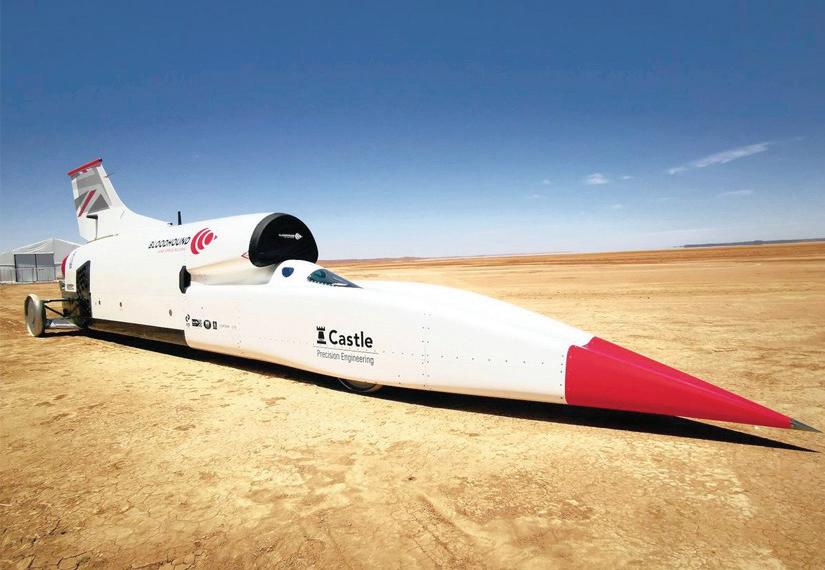
4 minute read
Engineering
The Square Kilometre Array telescope is an engineering marvel.
The construction timeline of the technically demanding and scientifically advanced Square Kilometre Array (SKA) is eight years, giving ample opportunity for specialist engineers to deploy their skills.
Advertisement
International teams, including South African engineers and scientists, have worked on the design phase of the latest in radio astronomy for many years, the result of which will see 197 dishes erected in South Africa (mostly around Carnarvon in the Northern Cape) and 131 072 antennas put up in Australia. South Africa has already erected 64 dishes, which make up the MeerKAT device (pictured above).
In South Africa, the South African Radio Astronomy Observatory (SARAO), a facility of the National Research Foundation, manages all radio astronomy initiatives and facilities in the country, including the MeerKAT in the Karoo.
The SKA will be the world’s largest radio telescope. In 2019, 15 countries involved in the SKA project gathered in Rome for the signing of the international treaty establishing the intergovernmental organisation that will oversee the delivery of the world’s largest radio telescope. In 2021, the Square Kilometre Array Observatory (SKAO) officially came into operation. The SKAO, with a head office in London, is tasked with delivering and operating the SKA.
Local communities are getting exposure to engineering as a result of the SKA project. The SARAO started offering artisan bursaries in 2011. More recently, the Klerefontein Training Centre was opened in Carnarvon, giving local high school pupils access to an accredited electrical engineering apprenticeship programme. The training programme will provide the MeerKAT and SKA radio telescopes with qualified artisans for their operations and maintenance.
The Department of Science and Innovation (DSI) and SKA are placing the recipients of bursaries in the data science programmes of Sol Plaatje University (SPU).
The long-anticipated attempt on the world landspeed record seemed to be within reach after successful tests were conducted early in 2020 at Hakskeenpan. The flat stretch of dusty land chosen for the attempt by a team called Bloodhound is not far from Verneuk Pan, where Sir Malcolm Campbell tried, and failed, to go beyond the record of 370.4km/h in the Blue Bird in 1929.
However, the Covid-19 pandemic has set the project back and the current owner of the project has chosen to sell it. The cost of completing the rocket installation and taking the car to from the UK to South Africa and go past 1 287km/h is estimated to be £8-million, based on the costs of the test programmes that have been completed.
The record now stands at 1 227.9km/h and the feat of engineering required to propel Andy Green (who holds the record) past that speed is awesome. Speeds above 1 000km/h were achieved during tests, but the focus was on how the car reacted to desert conditions. The car itself has been described as a combination of a rocket, a Formula 1 car and a jet aircraft. An extensive local project, in which 317 members of the Mier community cleared the track, was funded by the Provincial Government of the Northern Cape.
The South African Institute of Electrical Engineers (SAIEE) has launched a branch in Kimberley. The SAIEE Northern Cape Centre will attend to the needs of members and hold events of interest related to electrical or electronic engineering. SAIEE has 6 500 members around the country and is registered as a non-profit voluntary association with ECSA (Engineering Council of South Africa).
An important body in the South African context is the Institute of Municipal Engineering of Southern Africa (IMESA). A key focus for the body is to provide training in sustainable infrastructure asset management, something that has proved a challenge for many municipalities. Innovation The Northern Cape Innovation Forum (NCIF) has been established to bring together all sectors of society in taking advantage of innovation and technology in the province. The NCIF falls under SPU, in partnership with the National Department of Science and Innovation (DSI) and the Localisation Implementation Unit of the Council for Scientific and Industrial Research (CSIR).
The Northern Cape Department of Roads and Public Works is making 3D printing technology available to engineers and designers to allow them to create prototypes at lower cost.
Most of the new structures for the Sol Plaatje University ONLINE RESOURCES Consulting Engineers South Africa: www.cesa.co.za South African Institute of Electrical Engineers: www.saiee.org.za South African Radio Astronomy Observatory: www.sarao.ac.za Southern African Institution of Civil Engineering: www.civils.org.za Technology Localisation Implementation Unit: www.tliu.co.za

The Bloodhound land speed record project is up for sale. were subject to architectural design competitions. From a total of 59 entries, nine architectural firms were selected to enter the second round of the competition with five firms chosen as winners to complete different aspects of the project. The Sol Plaatje University Library and Student Resource Centre earned Aurecon an award at the 2018 CESA Aon Engineering Excellence Awards. The building on South Africa’s newest campus in Kimberley also won a Fulton Concrete Award. It was designed by designworkshop: sa, the construction work was done by Murray and Dickson and Aurecon’s brief was structural, civil, electrical, fire and wet services design. Another striking building, designed by Savage + Dodd, was “highly commended” at the World Architecture Festival. The multi-purpose building encompasses a residence, offices, meeting spaces and retail space on the ground floor. ■










